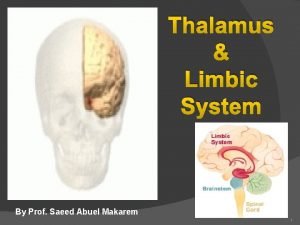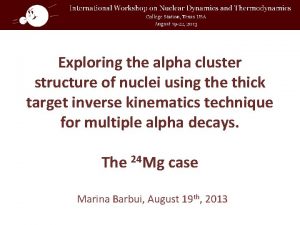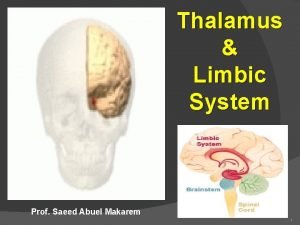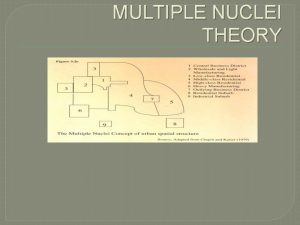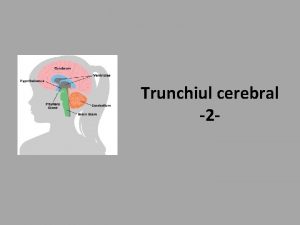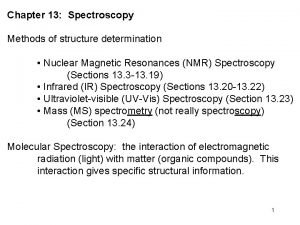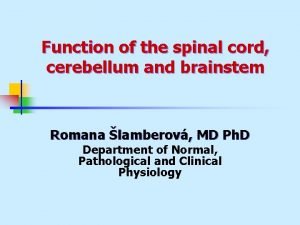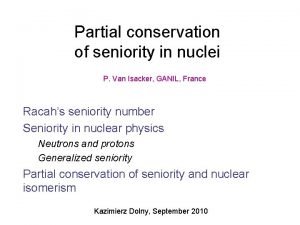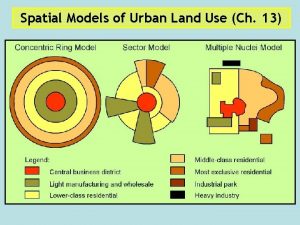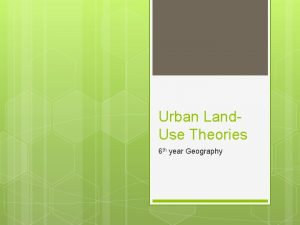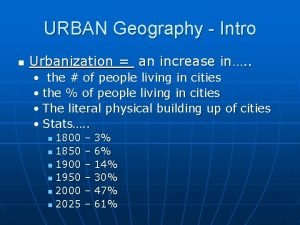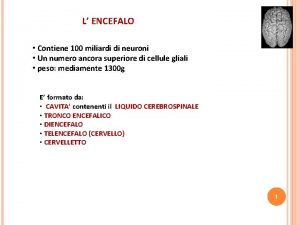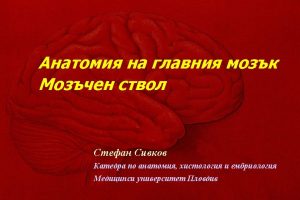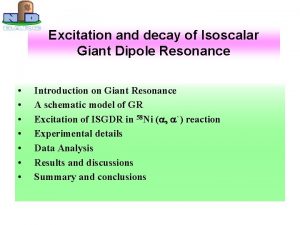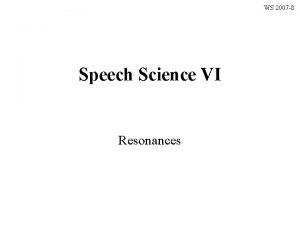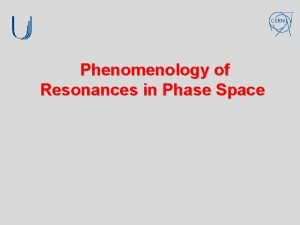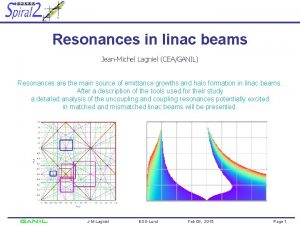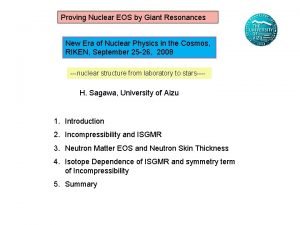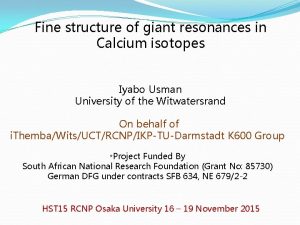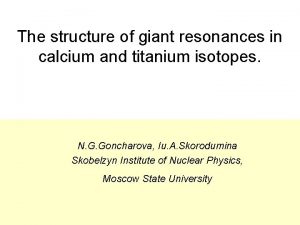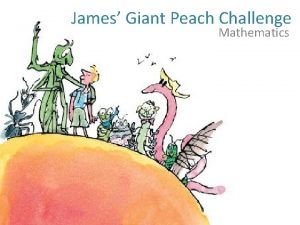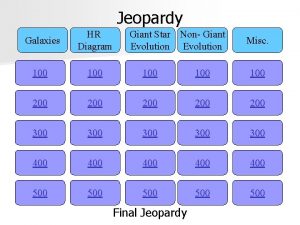Isoscalar Giant Monople Resonances in Nuclei An incompressive




























- Slides: 28

Isoscalar Giant Monople Resonances in Nuclei: An incompressive mode of Nuclear Vibration Mamoru Fujiwara (RCNP, Osaka Univ. ) EMIN 2018, 11 November, Moscow 1. Nuclear Incompressibility from the study of Giant Resonances 2. Experimental Results and Unsolved Problem 3. Future steps for new excitation modes in radioactive nuclei and alpha-cluster nuclei

Isoscalar Giant Resonances L=0 Breathing mode Squeezing mode L=2 L=1 L=3 L=1 IVGDR By M. Itoh of Tohoku Univ.

The nuclear matter incompressibility coefficient, K∞ is a very important physical quantity in the study of nuclei, supernova collapse, neutron stars, and heavy-ion collisions. It is directly related to the curvature of the nuclear matter (NM) equation of state (EOS), E = E[ρ]. ρ0 = 0. 16 fm-3 E/A 0 K Nuclear Equation of State Neutron Star Stellar Collapse Supernovae, Gravition Wave High-energy Heavy Ion Collisions

In the supernova explosion processes, the iron core absorbs electrons via the electron capture process, and the core is dominated with neutron excess nuclei. This process proceeds at ρ0 In the region ρ0, the core becomes hard Rebounding happens Explosion http: //heasarc. gsfc. nasa. gov /docs/snr. html Thus, an important factor for supernova explosion is the hardness of the core with neutron excess nuclei. Incompressibility K Isotope dependence of Incompressiblity: Ksym

Incompressional modes of giant resonances Compression modulus ↔ excitation energy GMR ISGDR

Symmetry energy in nuclear matter: where L and Ksym are the first and second order expansion coefficients of the symmetry energy at r 0.

From GMR data on 208 Pb and 90 Zr, K =240 10 Me. V See, e. g. Colo et al. Phys. Rev. C 70, 024307 This number is consistent with both GMR and ISGDR Data and with non-relativistic and relativistic calculations

The excitation energy of the GMR is expresses in the scaling model as: Where KA can be expressed as KCoul is, basically, model-independent. Kt ? ? ? It is estimated that the difference in Kt would be observable in the difference in EGMR

Grand Raiden spectrometer Faraday Cup for 0 deg. RCNP cyclotron facility Target 4 He++ beam M. Fujiwara et al. , NIM A 422 (1999) 484

Data Analysis Background rejection with the focal plane detector system of the spectrometer Grand Raiden. (a) one-dimensional spectrum along the vertical direction. Background events correspond to the hatched area. True and background events are in the central region. (b) The energy spectra for the true + background events, and for the background Events. (c) Difference spectrum for true events.

Uchida et al. , PRC 69, 051301 R (2004) (a, a’) spectra at 386 Me. V ISGDR MDA results for L=0 and L=1 ISGMR ISGDR ISGMR MDA analysis for 116 Sn data ISGDR ISGMR

Multipole-decomposition analysis 124 Sn(α, α’) Cross sections DWBA calculations (L=0~ 15) and IVGDR cross section ⊿L=0 ⊿L=1 ⊿L=2 ⊿L=3 ⊿L>3 ⊿L=1,⊿T=1

L=0 Breit-Wigner function Em (Me. V) Γm (Me. V) 112 Sn 16. 1 ± 0. 1 4. 4 ± 0. 2 114 Sn 16. 0 ± 0. 1 4. 0 ± 0. 1 116 Sn 15. 8 ± 0. 1 5. 7 ± 0. 3 118 Sn 15. 7 ± 0. 1 4. 6 ± 0. 2 120 Sn 15. 3 ± 0. 1 4. 8 ± 0. 2 122 Sn 15. 1 ± 0. 1 4. 5 ± 0. 2 124 Sn 14. 9 ± 0. 1 4. 5 ± 0. 3 112, 114, 118, 120, 122, 124 Sn 116 Sn : this work : Uchida et al.

ISGMR energy EISGMR Final data analysis

CHF and RPA using Gogny In 208 Pb, by inserting the data, one obtains K∞ = 230 Me. V. J. P. Blaizot et al. , Nucl. Phys. A 591 (1995) 435. J. P. Blaizot et al. , NPA 591 (1995) 435 FULL AGREEMENT BETWEEN THE NON-RELATIVISTIC FUNCTIONALS

Refs. 85; Phys. Lett B. 726 (2013) 178. 8; Phys. Rev. C, 68 (2003) 064602 86; Phys. Rev. Lett, 99 (2007) 162503 16; Phys. Rev. C 81 (2010) 034309 27; Phys. Lett. B. 718 (2012) 447 87; Phys. Lett. B. 760 (2016) 482 88; Phys. Lett. B. 637 (2006) 43 89; Phys. Rev. C. 88 (2013) 064313 90; Phys. Rev. C. 93 (2016) 064325 91; Phys. Lett. B. 748 (2015) 343 92; Phys. Rev. C. 93 (2016) 044324 Fig. 12. ISGMR strength distributions for various nuclei, extracted in the RCNP work. The data are from Refs. [[85], [86], [16], [27], [88], [89], [90], [91], [92]]. Taken from U. Garg and G. Colo Progress in Particle and Nuclear Physics, 101 (2018) 55 -95

K = 230 ~ 250 Me. V, Ksym = -640~ -400 Me. V Li et al. , PRL 99, 162503 (2007) Data from H. Sagawa et al. , Phys. Rev. C 76, 034327 (2007)


Fig. 23. The difference KA−KCoul. Z 2 A− 4∕ 3 from ISGMR in the Sn and Cd isotopes plotted as a function of the asymmetry parameter, (N−Z)/A. The solid and dashed lines represent quadratic fits to the respective data. Taken from Garg and Colo, Progress in Particle and Nuclear Physics.

Isoscalar 0+ strength functions By J. Terasaki, 2005 Notre Dame workshop Note that the GMR peak is expected at the excitation energy much lower than the calculation. We hope active experiments to measure the ISGMR at New RI beam facilities in Japan Russia, EU, USA, China.

Excitation Energy Alpha Cluster Nuclei (Ikeda Diagram)

Cluster phenomena in Nature Correlated di-quark model Q+ Pentaquark particle Clusters in Hadron Alpha Cluster in Nucleus by Yamazaki & Akaishi

Relation between the radius of 16 O and its potential energy B. Borderie et al. , Phys. Lett. B 755 (2016) 475.

Alpha Fullerene structure predicted by Tohsaki and Itagaki Akihito Tohsaki and Naoyuki Itagaki, http: //arxiv. org/abs/1708. 08193. Tosaki and Itagaki, Phys. Rev. C 97, 011401 (R) (2018).


Summary

Collaborators U. Garg, G. P. A. Berg. D. Patel, K. Sault, M. Fujiwara, M. N. Harakeh, K. Kawase, M. Itoh, A. Oikawa, T. Hayamizu, T. Takahashi, M. Uchida, M. Yosoi, T. Kawabata, T. Murakami, M. Sako, H. Akimune, A. Okamoto, C. Iwamoto, E. Khan, B. K. Nayak, T. Li, M. Hunyadi, R. G. T. Zegers, … University of Notre Dame, Research Center for Nuclear Physics, Osaka University, Kernfysisch Versneller Instituut, University of Groningen, Kyoto University, Tohoku University, Konan University, CNRS, ORSAY, Debrecen, NSCL

 Kcoul
Kcoul Multiple nuclei model
Multiple nuclei model Limbic system nuclei
Limbic system nuclei Galactic city model
Galactic city model Nuclei narrativi promessi sposi
Nuclei narrativi promessi sposi Nuclei di cure primarie
Nuclei di cure primarie Atomic nuclei
Atomic nuclei Nuclei
Nuclei African city model
African city model Thalamus vs hypothalamus
Thalamus vs hypothalamus Multiple nuclei model year
Multiple nuclei model year Hypothalamus nuclei
Hypothalamus nuclei Via indiretta gangli della base
Via indiretta gangli della base Nucleii trunchiului cerebral
Nucleii trunchiului cerebral High nc ratio
High nc ratio Nmr active and inactive nuclei
Nmr active and inactive nuclei Habenular nuclei
Habenular nuclei Via acustica
Via acustica Cerebellum function
Cerebellum function Nuclei
Nuclei Pros and cons of hoyt sector model
Pros and cons of hoyt sector model Harris ullman model
Harris ullman model Bid rent theory example
Bid rent theory example Nuclei midollo spinale
Nuclei midollo spinale Strengths of the multiple nuclei model
Strengths of the multiple nuclei model Chauncy
Chauncy Spinozerebelläre bahnen
Spinozerebelläre bahnen Who made the sector model
Who made the sector model Cerebellar peduncles
Cerebellar peduncles


